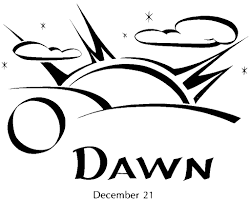The Advent season's golden period starts on December 17th. That's when we can begin praying, chanting or singing the great O antiphons.
Let us look at a bit of history about the origin of these great Antiphons. Or better still what are the Antiphons ?
Here is what I have collected from my google search :
An antiphon (Greek ἀντίφωνον, ἀντί "opposite" + φωνή "voice") in Christian music and ritual, is a responsory by a choir or congregation, usually in the form of aGregorian chant, to a psalm or other text in a religious service or musical work.
The Greater Advent or O Antiphons are antiphons used at daily prayer in the evenings of the last days of Advent in various liturgical Christian traditions. Each antiphon is a name of Christ, one of his attributes mentioned in Scripture. In the Roman Catholic tradition, they are sung or recited at Vespers from December 17 to December 23.In the Church of England they have traditionally been used as antiphons to the Magnificat at Evening Prayer.
http://en.wikipedia.org/wiki/Antiphon
The O Antiphons have been described as "a unique work of art and a special ornament of the pre-Christmas liturgy, filled with the Spirit of the Word of God". They "create a poetry that fills the liturgy with its splendor", and their composer shows "a magnificent command of the Bible's wealth of motifs". The antiphons are, in fact, a collage of Old Testament types of Christ. Their predominant theme is messianic, stressing the hope of the Savior's coming. Jesus is invoked by various titles, mainly taken from the prophet Isaiah. The sequence progresses historically, from the beginning, before creation, to the very gates of Bethlehem.
In their structure, each of the seven antiphons follows the same pattern, resembling a traditional liturgical prayer. Each O Antiphon begins with an invocation of the expected Messiah, followed by praise of him under one of his particular titles. Each ends with a petition for God's people, relevant to the title by which he is addressed, and the cry for him to "Come".
The seven titles attributed to Jesus in the antiphons are Wisdom (Sapientia in Latin), Ruler of the House of Israel (Adonai), Root of Jesse (Radix), Key of David (Clavis), Rising Dawn (Oriens), King of the Gentiles (Rex). and Emmanuel. In Latin the initials of the titles make an acrostic which, when read backwards. means: "Tomorrow I will be there" ("Ero cras"). To the medieval mind this was clearly a reference to the approaching Christmas vigil.
http://www.rc.net/wcc/antiphon.htm
In the Church's Liturgy of the Hours, Evening Prayer, also know as Vespers, always includes the great prayer of
Mary known as the Magnificat.
Each day, the Magnificat is preceded by a short verse or "antiphon" that links the prayer to the feast of
the day or the season of the year. In the last seven days of Advent
(December 17-24), the antiphons before the Magnificat are very
special. Each begins with the exclamation "O" and ends with a
plea for the Messiah to come. As Christmas approaches the cry becomes
increasingly urgent.
These moving "O Antiphons" were apparently composed in the
seventh or eighth century when monks put together texts from the Old Testament,
particularly from the prophet Isaiah, which looked forward to the coming
of our salvation. They form a rich, interlocking mosaic of scriptural images.
The great "O Antiphons" became very popular in the Middle Ages
when it became traditional to ring the great bells of the church each evening
as they were being sung.
Each of the O
Antiphons highlights a different title for the Messiah: O Sapientia (O Wisdom), O Adonai (O Lord), O Radix Jesse (O Root of Jesse), O Clavis David (O Key of David), O Oriens (O Rising Sun), O Rex Gentium (O King of the Nations), and O Emmanuel. Also, each
one refers to the prophecy of Isaiah of the coming of the Messiah. A particularly fascinating feature of the O Antiphons is that
the first letter of each invocation, when read backwards, forms an
acrostic in Latin: the first
letters of Sapientia, Adonai, Radix, Clavis, Oriens, Rex, andEmmanuel in reverse form the Latin
words: ERO CRAS. These
can be understood as the words of Christ, responding to his people's plea,
saying "Tomorrow I will be there."
Saying the O Antiphons as a family, whether during grace at meals,
in front of the manger scene, or in front of the Christmas tree, is a wonderful
Advent devotion. To make this devotion even more fruitful, read and
meditate together on the Scripture texts on which the antiphons are based.
December 17th:
O Sapientia (Is. 11:2-3; 28:29): "O Wisdom, you come forth from the mouth of the Most High. You fill the universe and hold all things together in a strong yet gentle manner. O come to teach us the way of truth."

O Sapientia (Is. 11:2-3; 28:29): "O Wisdom, you come forth from the mouth of the Most High. You fill the universe and hold all things together in a strong yet gentle manner. O come to teach us the way of truth."
December 18th:
O Adonai (Is. 11:4-5; 33:22): "O Adonai and leader of Israel, you appeared to Moses in a burning bush and you gave him the Law on Sinai. O come and save us with your mighty power."
O Adonai (Is. 11:4-5; 33:22): "O Adonai and leader of Israel, you appeared to Moses in a burning bush and you gave him the Law on Sinai. O come and save us with your mighty power."
December 19th:
O Radix Jesse (Is. 11:1, 10): "O stock of Jesse, you stand as a signal for the nations; kings fall silent before you whom the peoples acclaim. O come to deliver us, and do not delay."
O Radix Jesse (Is. 11:1, 10): "O stock of Jesse, you stand as a signal for the nations; kings fall silent before you whom the peoples acclaim. O come to deliver us, and do not delay."
December 20th:
O Clavis David (Is. 9:6; 22:22): "O key of David and scepter of Israel, what you open no one else can close again; what you close no one can open. O come to lead the captive from prison; free those who sit in darkness and in the shadow of death."
O Clavis David (Is. 9:6; 22:22): "O key of David and scepter of Israel, what you open no one else can close again; what you close no one can open. O come to lead the captive from prison; free those who sit in darkness and in the shadow of death."
December 21st:
O Oriens (Is. 9:1): "O Rising Sun, you are the splendor of eternal light and the sun of justice. O come and enlighten those who sit in darkness and in the shadow of death."
O Oriens (Is. 9:1): "O Rising Sun, you are the splendor of eternal light and the sun of justice. O come and enlighten those who sit in darkness and in the shadow of death."
December 22nd:
O Rex Gentium (Is. 2:4; 9:5): "O King whom all the peoples desire, you are the cornerstone which makes all one. O come and save man whom you made from clay."
O Rex Gentium (Is. 2:4; 9:5): "O King whom all the peoples desire, you are the cornerstone which makes all one. O come and save man whom you made from clay."
December 23rd:
O Emmanuel (Is. 7:14) : "O Emmanuel, you are our king and judge, the One whom the peoples await and their Savior. O come and save us, Lord, our God."
O Emmanuel (Is. 7:14) : "O Emmanuel, you are our king and judge, the One whom the peoples await and their Savior. O come and save us, Lord, our God."
No comments:
Post a Comment